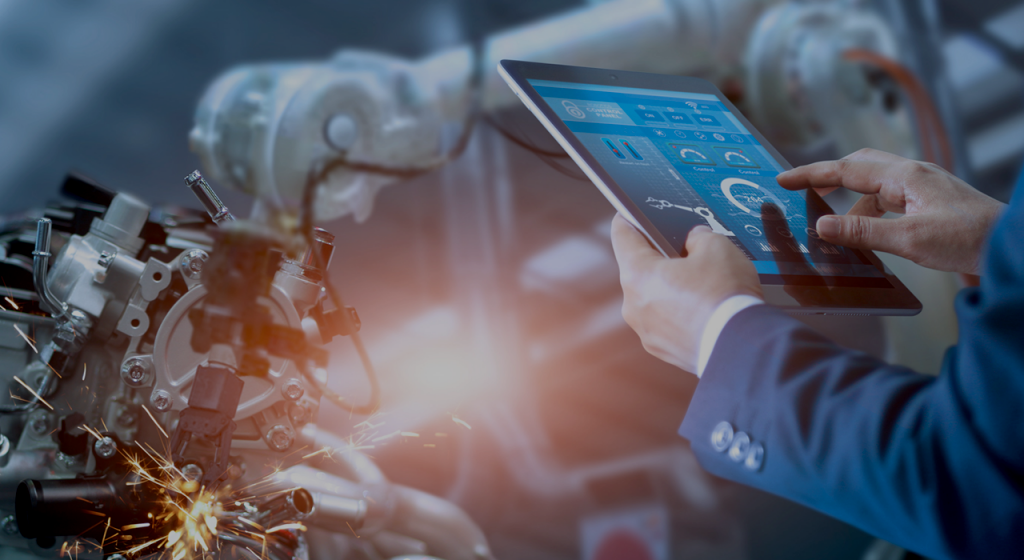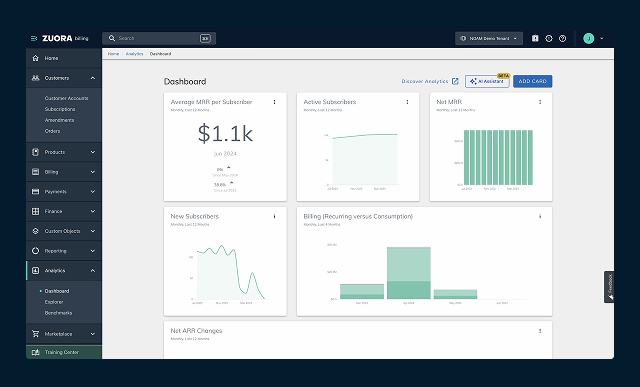Manufacturing is getting a big tech shakeup that is improving customer experience and automating processes. Conquer the market by uncovering what Industry 4.0 can do to scale your business and create great customer experiences.
Manufacturing is in transition
The entire manufacturing value chain is experiencing a technology-driven transition in terms of capabilities and expectations.
This change isn’t simply about replacing people with machines it’s about how people, interconnected sensors, machines and artificial intelligence (AI) can work together more effectively.
This isn’t revolutionary for manufacturers but it is a shift towards increasing productivity, delivering quality products, delighting customers and achieving greater profitability and sustainability.
What make this change distinct are the unprecedented technological capabilities potentially affecting all aspects of manufacturing execution.
Industry 4.0 will affect manufacturing at the individual operation level as well as across industries and the supply chain. Essentially, to stay competitive, manufacturing needs to adopt new technologies, and do so quickly.
CATALYSTS OF CHANGE
There are four key catalysts driving the Industry 4.0 transition in manufacturing:
- Pervasive connectivity
Connectivity has permeated everything. Systems used to stand in silos and now through Industry 4.0 can be connected. This ability to share data across systems has changed the way businesses deliver goods and services.
- Smart sensors and enabled data sources
Affordable sensor technology has given us the ability to access data at the atomic level of devices through the Industrial Internet of Things (IIoT). We’re no longer stuck reacting after an unpredicted change takes place, instead we have up to the second information that allows us to be proactive.
How is this different from a non-smart sensor approach? An example, a smart sensor in a cold chain can send a warning when a food item exceeds the desired temperature. The sensor then follows up with a suggested action an alert indicating the food item is no longer sellable because the temperature exceeded the maximum for a specified amount of time. In contrast, non-smart sensors would only record all temperature readings on a constant basis with no suggested action.
Data that was once too expensive to capture can now easily be gathered and used to make better, data driven decisions.
- Advanced analytics and big data storage
Traditional business intelligence and data warehousing are moving to richer visual and collaborative predictive analytics models that tap into more dynamic, real time and non-explicitly related data. Advanced analytics can answer critical questions sometimes before they are asked.
For example, using machine learning, yields could be compared and optimised. Leveraging supplier item information, the system could determine if supplier product quality may be a significant factor. These could be done without running an analysis of supplier parts or machine yield.
- Accelerated and advanced computing
Raw computing power continues to move at blinding speed with cloud and edge computing. These advancements are blurring the scale and the capacity into what seems potentially like an unlimited resource.
CATALYSTS TURN INTO CAPABILITIES
Industry 4.0 will combine one or more of these catalysts into new, innovative capabilities.
AI is already transitioning from an academic exercise to an effective business proposition. The practical adoption of AI through machine learning results directly from enhanced connectivity, smarter sensors, advanced analytics and super scalable systems.
AI allows us to be proactive and advance manufacturing, product life- cycle management and enterprise asset management. It is proactively learning and not just basing every decision on baseline metrics. AI can use performance metrics accumulated over run time or placed orders to predefine reorder points. Without AI, we need to know the questions we want to ask a system. With AI, it can tell us the questions we should be asking.
Product development and processing are also advanced by Industry 4.0. The advances of additive manufacturing (3D printing) and other technologies are supported by better data sharing and the power of iterations is supported by advanced analytics, unprecedented computing power and the concept of digital twins.
What is a digital twin (also known as a “device shadow”)?
It’s a computerised simulation of a physical asset that reflects the status of the actual asset. This is usually fed by sensors. Using a digital twin can help product development and process innovation by creating an environment that allows us to test the performance of any given instance of a product.
Industry 4.0 can extend beyond the manufacturer into the use of the product in the customer’s hands by using the Internet of Things (IoT). Charging based on real usage and thus the value of the product becomes possible. An example, GE charging for thrust hours on jet engines or HP charging per print.
After-sales service can be optimised to reduce cost and improve customer satisfaction through informed preventive and proactive maintenance and using this information to improve product design.
COMPETITIVE OPPORTUNITY
The biggest hurdle to onboard Industry 4.0 capabilities is sustaining current daily operational execution. But, manufacturers who make rapid progress will reap early benefits and enjoy the promise of several competitive advantages.
- Become globally responsive.
- Keep up with the rapid pace of modern business changes and challenges.
- Reach new performance levels through optimised processes and productivity increases.
- Drive the notion of a “Digital Thread” of information across the value chain, which allows for analysis of inefficiencies so that every area within the product life-cycle can be optimised.
- Allow disruptive change, enhanced business models and incremental revenue/ growth potential.
POSSIBLE INDUSTRY 4.0 APPROACHES
Given all the new technology, what would an Industry 4.0 manufacturer look like when you compare it to a legacy approach?

Let’s break it down by our four catalysts:
PERVASIVE CONNECTIVITY
Legacy Approach
- Functionally distinct approaches to solutions
- Even best of breed systems developed in isolation
- Heavy customisation of individual systems
- System integration complicated through limited technology and security concerns
- Integration and information exchange slow with poor change management
- Paper/manual supply chain systems
- Poor enterprise informational model limits deeper analytics
Industry 4.0 Approach
- Formalised ERP/MES integration via well-defined configurable interfaces and extensions
- Interoperability via standards-based solutions
- Loosely coupled architecture supports atomic level upgrades and enhancements
- APIs exposing over 1800 business services
- Modularised, non-invasive secure computing approaches
- Collaborative supply chain environment
SMART SENSORS
Legacy Approach
- Factory floor islands of automation with limited connectivity and flexibility
- Time-streamed single data-point values without context
- Wide-spread manual data collection and corresponding error-prone data entry
- Multi-level (PLC/HM /SCADA / MES) data aggregation and management hierarchies
- Minimal data structures or directly actionable data delivery
Industry 4.0 Approach
- Purpose-built access direct to spectrum of devices
- Device support for complex data structures
- Cognitive context in support of immediate action
- Directed intelligent action to remote devices
- Flexible to operational changes through configuration
- Guided operator data entry options with validity checks and flow control
ADVANCED ANALYSIS
Legacy Approach
- Large data sets but limited information
- Isolated functional data sets with limited interoperability
- Trend reporting without intelligent evaluation
- Analytics limited to descriptive predefined views
- Flat data constructs barriers to correlation
- Poor enterprise informational model limits deeper analytics
Industry 4.0 Approach
- Transaction-centric audit trail
- Enterprise view of data enables deeper understanding
- Transaction duration trends and basis for process improvement
- Lumpy data model integrates text, values, images
- Shared data store and synchronisation
- Cloud ERP
ADVANCED COMPUTING
Legacy Approach
- Slow localised computing infrastructure
- IT outpaced by security and technology requirements
- Incremental capability embraced on multi-year version cycles with prohibitive efforts around upgrades
Industry 4.0 Approach
- Restrictive localisation and personalisation limited to high level access
- Flexible deployment architecture
- Elastic Compute
- Predictable IT costs and availability
- 3rd party verified integrated security
- Configurable fine grained user access personalisation and extensibility empowered via agile technologies
LOOKING FORWARD
Industry 4.0 is here. Manufacturers who ignore the advancements within the industry will find themselves falling behind the competition. To prevent losing your place within the value chain, look at getting your facility and business strategy assessed.




